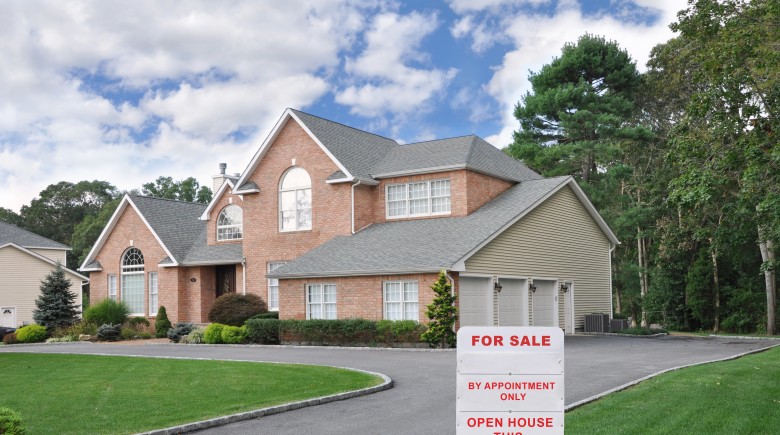You may have already heard. There’s a new twist on house flipping. Upscale. And I mean really upscale. A million dollars or more.
This raises the question: is it for you?
Homes at those prices rose more than one-third last year, compared to 2011, says market researcher RealtyTrac.
One major reason: The lower end of flips has run dry in many areas.
High-end flips are particularly attractive in hard-hit housing areas. Many of these are areas where prices of all homes have gone south, though even more so in million dollar and plus homes.
Among those areas is Los Angeles, where RealtyTrac cited 248 flips with an average selling price of $1.7 million last year. Gross profit margins were attractive at more than $331,000 or about one fourth the amount above the owner’s cost,
One reason it might be for you is that more such homes are now available in lieu of the traditional lower-priced units that many buyers are scrambling to get.
Where you find such homes is also not complicated. Auctions, of course, both bankruptcy and others. Also, some flippers have reportedly been making enough money to hire others to help them find properties.
There’s also not a huge difference in how buyers rehab high-end homes are opposed to lower priced ones. New appliances, fixtures, perhaps redoing bedrooms. All traditional improvements, though these often cost more because buyers expect top-of-the-line when they are looking at million dollar-plus properties.
But on the negative side:
—High-end homes generally take longer to sell than mid-or-priced.
—Renovation costs can be a lot higher than small-time flippers are used to handling.
So that does that mean these homes are definitely out of your ball park if you are a small investor?
Not necessarily.
There’s a premium here on buying smart to get upscale amenities that impress buyers without adding a lot of money to the asking price. There’s also a premium here on buying used (but still new-looking) amenities that owners can save money by doing their own installations or labor. The later is often a major cost that can be avoided.
For investors with little or no available cash, there’s also the requirement to find partners who do have money in their pockets.
Still, if you want into this game, it’s like higher stakes poker. Very often, more investment or upfront money is needed. And it’s more at risk.
The survey found investors who actually lost money.
Whatever you do, and however you manage it, a key element here is timing.
Experts agreed that a six-month turnaround period is best to maximize your profits. And don’t expect a superficial beauty treatment such as a new paint job to wow your potential buyers. Expect them to expect more. Even in a time of declining values, buyers still expect luxury when they are looking at million dollar homes.
You may have already heard. There’s a new twist on house flipping. Upscale. And I mean really upscale. A million dollars or more.
This raises the question: is it for you?
Homes at those prices rose more than one-third last year, compared to 2011, says market researcher RealtyTrac.
One major reason: The lower end of flips has run dry in many areas.
High-end flips are particularly attractive in hard-hit housing areas. Many of these are areas where prices of all homes have gone south, though even more so in million dollar and plus homes.
Among those areas is Los Angeles, where RealtyTrac cited 248 flips with an average selling price of $1.7 million last year. Gross profit margins were attractive at more than $331,000 or about one fourth the amount above the owner’s cost,
One reason it might be for you is that more such homes are now available in lieu of the traditional lower-priced units that many buyers are scrambling to get.
Where you find such homes is also not complicated. Auctions, of course, both bankruptcy and others. Also, some flippers have reportedly been making enough money to hire others to help them find properties.
There’s also not a huge difference in how buyers rehab high-end homes are opposed to lower priced ones. New appliances, fixtures, perhaps redoing bedrooms. All traditional improvements, though these often cost more because buyers expect top-of-the-line when they are looking at million dollar-plus properties.
But on the negative side:
—High-end homes generally take longer to sell than mid-or-priced.
—Renovation costs can be a lot higher than small-time flippers are used to handling.
So that does that mean these homes are definitely out of your ball park if you are a small investor?
Not necessarily.
There’s a premium here on buying smart to get upscale amenities that impress buyers without adding a lot of money to the asking price. There’s also a premium here on buying used (but still new-looking) amenities that owners can save money by doing their own installations or labor. The later is often a major cost that can be avoided.
For investors with little or no available cash, there’s also the requirement to find partners who do have money in their pockets.
Still, if you want into this game, it’s like higher stakes poker. Very often, more investment or upfront money is needed. And it’s more at risk.
The survey found investors who actually lost money.
Whatever you do, and however you manage it, a key element here is timing.
Experts agreed that a six-month turnaround period is best to maximize your profits. And don’t expect a superficial beauty treatment such as a new paint job to wow your potential buyers. Expect them to expect more. Even in a time of declining values, buyers still expect luxury when they are looking at million dollar homes.





